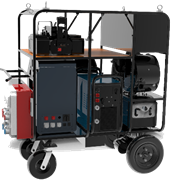Talk about the requirements of spot welding for welding robots
Date:2021-10-26 Views:823
Spot welding does not have high requirements for welding robots. Because spot welding only requires point position control, there are no strict requirements for the movement trajectory of the welding tongs between points, which is also the reason why robots were originally only used for spot welding. Robots for spot welding should not only have sufficient load capacity.

Moreover, when shifting between points, the speed should be fast, the movements should be smooth, and the positioning should be accurate to reduce the time required for shifting and improve work efficiency. The amount of load capacity required for a spot welding robot depends on the type of welding clamp used. For welding tongs separated from transformers, a robot with a load of 30-45kg is sufficient.
However, on the one hand, this type of welding clamp is not conducive to robots extending the welding clamp into the workpiece for welding due to the long secondary cable line and high electrical energy loss; On the other hand, the cable oscillates continuously with the robot's movement, resulting in faster cable damage. Therefore, the use of integrated welding tongs is gradually increasing. This type of welding clamp, along with the transformer, has a mass of about 70kg.
Considering that robots need to have sufficient load capacity to deliver welding tongs to spatial positions for welding at a high acceleration, heavy-duty robots with a load of 100-150kg are generally selected. In order to adapt to the requirements of rapid short distance displacement of welding tongs during continuous spot welding. The new heavy-duty robot has added the function of completing 50mm displacement within 0.3 seconds. This places higher demands on the performance of motors, the computational speed and algorithms of microcomputers.
Spot welding does not have high requirements for welding robots. Because spot welding only requires point position control, there are no strict requirements for the movement trajectory of the welding tongs between points, which is also the reason why robots were originally only used for spot welding. Robots for spot welding should not only have sufficient load capacity.

Moreover, when shifting between points, the speed should be fast, the movements should be smooth, and the positioning should be accurate to reduce the time required for shifting and improve work efficiency. The amount of load capacity required for a spot welding robot depends on the type of welding clamp used. For welding tongs separated from transformers, a robot with a load of 30-45kg is sufficient.
However, on the one hand, this type of welding clamp is not conducive to robots extending the welding clamp into the workpiece for welding due to the long secondary cable line and high electrical energy loss; On the other hand, the cable oscillates continuously with the robot's movement, resulting in faster cable damage. Therefore, the use of integrated welding tongs is gradually increasing. This type of welding clamp, along with the transformer, has a mass of about 70kg.
Considering that robots need to have sufficient load capacity to deliver welding tongs to spatial positions for welding at a high acceleration, heavy-duty robots with a load of 100-150kg are generally selected. In order to adapt to the requirements of rapid short distance displacement of welding tongs during continuous spot welding. The new heavy-duty robot has added the function of completing 50mm displacement within 0.3 seconds. This places higher demands on the performance of motors, the computational speed and algorithms of microcomputers.











